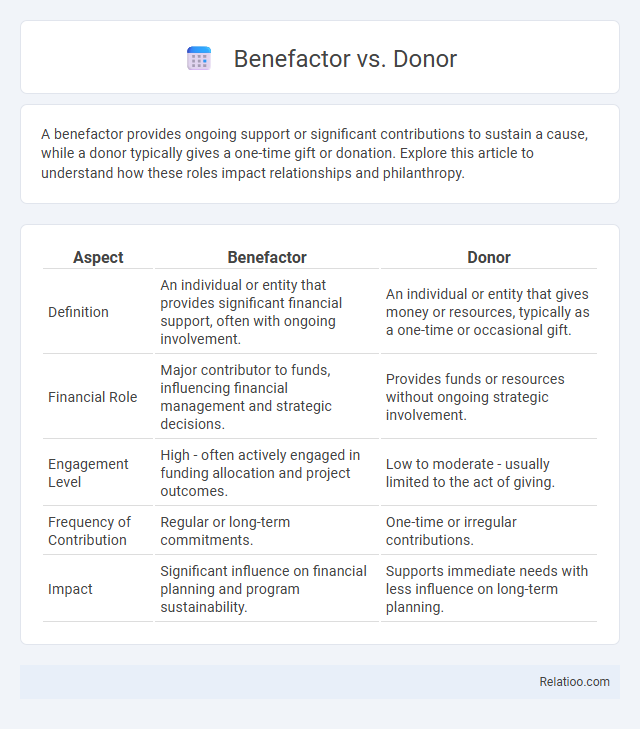A benefactor provides ongoing support or significant contributions to sustain a cause, while a donor typically gives a one-time gift or donation. Explore this article to understand how these roles impact relationships and philanthropy.
Table of Comparison
| Aspect | Benefactor | Donor |
|---|---|---|
| Definition | An individual or entity that provides significant financial support, often with ongoing involvement. | An individual or entity that gives money or resources, typically as a one-time or occasional gift. |
| Financial Role | Major contributor to funds, influencing financial management and strategic decisions. | Provides funds or resources without ongoing strategic involvement. |
| Engagement Level | High - often actively engaged in funding allocation and project outcomes. | Low to moderate - usually limited to the act of giving. |
| Frequency of Contribution | Regular or long-term commitments. | One-time or irregular contributions. |
| Impact | Significant influence on financial planning and program sustainability. | Supports immediate needs with less influence on long-term planning. |
Understanding the Terms: Benefactor vs Donor
A benefactor is an individual or organization that provides financial support, often through substantial gifts or endowments, typically aimed at long-term impact, while a donor generally refers to anyone who gives money, goods, or services, regardless of the amount or purpose. The term benefactor implies a more significant and ongoing contribution, often associated with philanthropy or nonprofit organizations, whereas donor encompasses all levels of giving, including one-time or small contributions. Understanding these distinctions helps clarify the scale and intent behind contributions in charitable contexts.
Key Differences Between Benefactors and Donors
Benefactors contribute significant financial support or assets, often establishing legacies through sizeable donations that impact organizations or causes long-term. Donors typically provide smaller, one-time or recurring contributions without the same level of influence or recognition as benefactors. Your understanding of these key differences ensures proper acknowledgment and management of philanthropic relationships.
Historical Context of Benefactors and Donors
Historically, benefactors have been prominent figures who provided substantial financial support to institutions, often leaving lasting legacies through philanthropy and endowments, especially in arts, education, and religion. Donors, while also contributing funds or goods, typically engaged in smaller-scale or one-time donations without the same emphasis on legacy or institutional patronage. The role of benefactors evolved during the Renaissance as wealthy patrons funded artists and scholars, contrasting with donors whose contributions have varied widely across different cultures and periods.
The Roles and Responsibilities of a Benefactor
A benefactor provides substantial financial support or resources to an organization or individual, often with the expectation of creating a lasting impact or legacy. Unlike donors who may give smaller or one-time contributions, benefactors typically engage in strategic philanthropy, guiding the allocation of funds to achieve specific goals. Their responsibilities include ensuring the sustainability of projects, fostering relationships with recipients, and sometimes influencing organizational direction through their support.
The Impact of Donors in Modern Philanthropy
Donors play a crucial role in modern philanthropy by providing essential financial resources that support diverse charitable initiatives and drive social change. Unlike benefactors, who often engage in ongoing relationships or large-scale endowments, donors may contribute one-time or regular gifts that empower nonprofit organizations to address immediate community needs. The sustained impact of donors fuels innovation, expands program reach, and enhances the effectiveness of philanthropic efforts worldwide.
Motivations: Why Become a Benefactor or Donor?
Benefactors and donors both provide financial support, but benefactors typically contribute larger, long-term investments often motivated by legacy-building and philanthropic goals, while donors may give smaller, one-time gifts driven by empathy or immediate need. Your motivation to become a benefactor could stem from a desire to create lasting impact, influence an organization's future, or support causes aligned with your values. Donors usually seek to make a meaningful difference quickly or help specific projects, reflecting personal connections or charitable inclinations.
Case Studies: Notable Benefactors vs Prominent Donors
Case studies reveal that notable benefactors often contribute strategically to long-term projects, such as Andrew Carnegie's funding of public libraries, while prominent donors like Bill and Melinda Gates focus on philanthropic grants addressing immediate global health issues. Your choice between becoming a benefactor or donor depends on whether you prefer sustained impact through endowments or targeted, high-impact donations. Both roles play critical parts in advancing social causes, with benefactors typically shaping institutional legacies and donors driving urgent humanitarian efforts.
Legal and Tax Implications for Benefactors and Donors
Understanding the legal and tax implications for benefactors and donors is crucial for maximizing charitable contributions and ensuring compliance. Benefactors typically engage in more substantial, often conditional gifts, which may involve complex estate planning and tax deductions under IRS Section 170, while donors generally make straightforward, unconditional contributions eligible for standard charitable deduction limits. Your ability to leverage these differences can optimize tax benefits and clarify legal responsibilities when structuring your philanthropy.
How Organizations Engage Benefactors and Donors
Organizations engage benefactors by cultivating long-term relationships through personalized communication and exclusive recognition programs that highlight their significant, often transformative contributions. Donors are engaged via targeted campaigns, transparent impact reporting, and varied giving options that encourage ongoing support and build trust. Effective engagement strategies differentiate benefactors' deeper commitment and philanthropy from donors' broader participation, optimizing fundraising outcomes.
Choosing Your Path: Should You Be a Benefactor or a Donor?
Choosing your path between being a benefactor or a donor depends on the level of engagement and impact you desire in philanthropy. Benefactors typically provide substantial support, often shaping the direction and sustainability of organizations through major gifts or endowments, while donors contribute varying amounts to support causes without necessarily influencing organizational strategy. Understanding these roles helps align your giving with your goals for influence, commitment, and legacy in charitable efforts.

Infographic: Benefactor vs Donor
 relatioo.com
relatioo.com